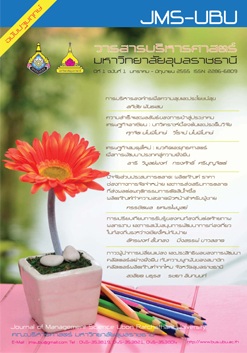การเปรียบเทียบการรับรู้ของคนท้องถิ่นต่อศักยภาพ ผลกระทบ และการสนับสนุนการ พัฒนาการท่องเที่ยวในท้องถิ่นระหว่างเชียงใหม่กับปาย
Main Article Content
บทคัดย่อ
บทความนี้มีวัตถุประสงค์เพื่อศึกษาเปรียบเทียบความสัมพันธ์เชิงสาเหตุของการรับรู้ของคนท้องถิ่นต่อศักยภาพของแหล่งท่องเที่ยว ผลกระทบของการท่องเที่ยว และการสนับสนุนการพัฒนาการท่องเที่ยวในท้องถิ่นระหว่างเชียงใหม่และปาย โดยวิเคราะห์ข้อมูลด้วยแบบจำลองสมการโครงสร้าง (Structural Equation Mode l: SEM) ที่ประกอบด้วยตัวแปรสังเกตได้ 15 ตัวแปร ตัวแปรแฝงภายนอก 4 ตัวแปร คือ ศักยภาพของแหล่งท่องเที่ยว ผลกระทบทางด้านเศรษฐกิจ สังคมและวัฒนธรรม และสิ่งแวดล้อม และตัวแปรแฝงภายใน 1 ตัวแปร คือ การสนับสนุนการพัฒนาการท่องเที่ยวในท้องถิ่น
ผลการศึกษา พบว่า คนท้องถิ่นเห็นว่าความร่วมมือของภาคเอกชนและสนับสนุนขององค์การปกครองส่วนท้องถิ่น(อปท.) เป็นองค์ประกอบสำคัญของการสนับสนุนการพัฒนาการท่องเที่ยวในท้องถิ่น โดยผลกระทบด้านเศรษฐกิจเป็นปัจจัยหลักที่มีอิทธิพลต่อการสนับสนุนการพัฒนาการท่องเที่ยวในท้องถิ่น แต่มีขนาดของอิทธิพลแตกต่างกันตามแหล่งท่องเที่ยว โอกาสในการมีงานทำของคนท้องถิ่นเป็นผลกระทบทางเศรษฐกิจที่สำคัญของแหล่งท่องเที่ยวทั้งสอง และคนท้องถิ่นในแหล่งท่องเที่ยวทั้งสองต้องการให้มีการพัฒนาสิ่งดึงดูดใจทางด้านกายภาพและสิ่งอำนวยความสะดวกอย่างต่อเนื่อง ในขณะที่ผลกระทบด้านสังคม-วัฒนธรรม และสิ่งแวดล้อมสร้างความกังวลให้คนท้องถิ่นเพียงเล็กน้อย ผลการศึกษาที่ได้สะท้อนให้เห็นว่า แต่ละท้องถิ่นควรมีนโยบายการพัฒนาการท่องเที่ยวแตกต่างกันภายใต้การมีส่วนร่วมของทุกภาคส่วน เพื่อนำมาสู่การพัฒนาการท่องเที่ยวที่ยั่งยืนในท้องถิ่น
Downloads
Article Details
References
Akis, S., Peristianis, N. & Warner, J. (1996). Residents’ attitudes development: The case of Cyprus. Tourism Management, 17(7), 481-494.
Allen, L. R., Long, P. T., Perdue, R. R. & Kieselbach, S. (1988). The impacts of tourism development on residents’ perceptions of community life. Journal of Travel Research, 27(1), 16-21.
Ap, J. (1990). Residents’ perceptions research on the social impacts of tourism. Annals of Tourism Research, 17(4), 610-616.
Bastias-Perez, P. & Var, T. (1995). Perceived impacts of tourism by residents. Annals of Tourism Research, 22(1), 208-210.
Butler, R. W. (1980). The concept of a tourism areas cycle of evaluation: Implication for management of
resources. Canadian Geographer, 24(1), 5-12.
Chen, J. S. (2001). Assessing and visualizing tourism impacts from urban residents’ perspectives. Journal
of Hospitality & Tourism Research, 25(3), 235-250.
Cooke, K. (1982). Guidelines for socially appropriate tourism development in British Columbia. Journal of
Travel Research, 21(1), 22-28.
Dyer, P., Gursoy, D., Sharma, B. & Carter, J. (2007). Structural modeling of resident perceptions of tourism and associated development on the Sunshine Coast, Australia. Tourism Management, 28(2), 409-422
Getz, D. (1994). Residents' attitudes toward tourism: A longitudinal study in Spey Valley, Scotland. Tourism
Management, 15(4), 247-258.
Gursoy, D., Jurowski, C. & Uysal, M. (2002). Resident attitudes: A structural modeling approach. Annals of
Tourism Research, 29(1), 79-105.
Hair, J. F., Black, W. C., Babin, B. J. & Anderson, R. E. (2010). Multivariate Data Analysis, 7th ed. New Jersey: Prentice-Hall International.
Jurowski, C., Uysal, M. & Williams, D. R. (1997). A theoretical analysis of host community resident reactions to tourism. Journal of Travel Research, 36(2), 3-11.
Kaosa-ard, M. (2007). Mekong Tourism: Blessings for All?. Bangkok: White Lotus.
Ko, D. W. & Stewart, W. P. (2002). A structural equation model of residents’ attitudes for tourism
development. Tourism Management, 23(5), 521-530.
Kreag, G. (2001). The Impacts of Tourism. Retrieved October 10, 2008, from http://www.seagrant.umn.edu/tourism/pdfs/ImpactsTourism.pdf.
Lankford, S. V. & Howard, D. R. (1994). Developing a tourism impacts attitude scale. Annals of Tourism
Research, 21(1), 121-139.
Lawton, L. (2005). Resident perceptions of tourism attractions on the Gold Coast of Australia. Journal of Travel Research, 44(2), 188-200.
Lepp, A. (2007). Residents’ attitudes towards tourism in Bigodi village, Uganda. Tourism Management,
(3), 876-885.
Lindberg, K. & Johnson, R. L. (1997). Modeling resident’s attitude toward tourism. Annals of Tourism Research, 24(2), 402-424.
Liu, J. C. & Var, T. (1986). Resident attitudes toward tourism impacts in Hawaii. Annals of Tourism Research, 13(2), 193-214.
Nunnally, J. C. & Bernstein, I. H. (1994). Psychometric theory (3rd ed.). New York: McGraw-Hill.
Parasuraman, A., Zeithaml, V. & Berry, L. (1988). SERVQUAL: A multiple-item scale for measuring consumer perceptions of services quality. Journal of Retailing, 64(1), 12-40.
Perdue, R. R., Long, P. T. & Allen, L. (1990). Resident support for tourism development. Annals of Tourism
Research, 17(4), 586-599.
Ritchie, J. R. B. (1988). Consensus policy formulation in tourism: Measuring resident views via survey
research. Tourism Management, 9(3), 199-212.
Untong, A. (2006). Attitude of local residents on tourism impacts: A case study of Chiang Mai and Chiang
Rai. Proceeding 12th Asia Pacific Tourism Association and 4th APacCHRIE Joint Conference, June
-29 2006. Hualien, Taiwan.
Untong, A., Phuangsaichai, S., Taweelertkunthon, N. & Tejawaree, J. (2006). Income distribution and
community based tourism: Three case studies in Thailand. The Journal of GMS Development
Studies, 3(1), 69-81.
Yoon, Y., Gursoy, D. & Chen, J. S. (2001). Validating a tourism development theory with structural equation
modeling. Tourism Management, 22(4), 363-373.
